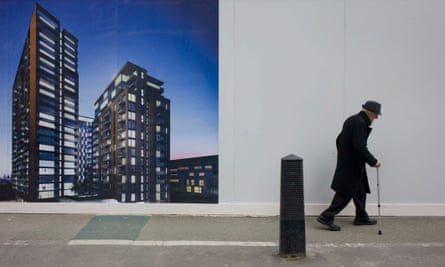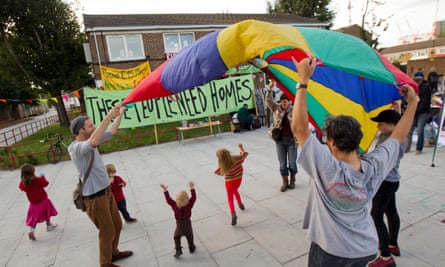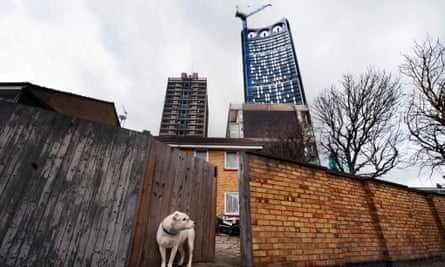When Amal had stopped crying, she apologised. “I wake up so sick, you know? I have to go to study but I feel so sick.” A victim of domestic violence and now a single mother, she lives with her three young children in grimy temporary accommodation in Tooting, south London. She was telling me that Wandsworth council, which has a legal obligation to house the family, tried sending them to a rented flat on the outskirts of Newcastle, then suggested West Bromwich. She’d never heard of either place. “I said to them, ‘I already told you, I have a job interview in London, I am studying in London, my children are at school in London, my ex-husband visits every week to help with the children.’”
West Bromwich, the council insisted, was her last chance. Otherwise she would be declared “intentionally homeless”, and be put out with her young children on the street. “They said, ‘just one option: West Bromwich.’ If I said no, they wouldn’t give me another chance.”
This was one London council’s response to the housing crisis – to spend £5m on properties for their poorer families, hundreds of miles away, while across the borough, the Meccano scaffolds rose up for the £15bn development of Nine Elms, where most flats will cost more than £1m.
The same year I met Amal, in 2014, on the other side of London the now notorious Focus E15 Mums were stepping up their campaign to remain in the city where they’d been born. “Nine billion pounds on the Olympics and they’re telling us and our babies we have to go live in Hastings,” lamented 19-year-old Adora Chilaisha during their occupation of East Thames housing association offices, as the hokey cokey played out in the background. “There’s no way I’m going anywhere,” she said. “My boy Desean is one, and I don’t want him to grow up away from his family, from his home. I don’t know anyone in Hastings.”

Two years later, both Amal and Adora and their children are still in London after a long and exhausting struggle against the authorities to simply stay where they are. Meanwhile, those same authorities prostrate themselves before luxury property developers, Chinese business conglomerates and buy-to-let rentiers.
Gentrification is an intensely emotive issue with almost endless potential for argument. That shouldn’t be in the least bit surprising – it speaks to fundamental questions of home, identity and community, how those places define us, and how we define them. The process of displacement of society’s poorest members is, of course, not a new thing. You can trace it back centuries, to a time when there was a literal gentry responsible for social cleansing; when the bailiffs were on horseback and “artisanal” was a descriptor of a pre-industrial social class, rather than vogueish hipster branding.
Nonetheless, there is something of the zeitgeist about gentrification. Until a few years ago, only academic geographers and housing campaigners used the term. In recent years, however, the subject has entered the mainstream, and the word has become increasingly ubiquitous in what seems like almost every city across the world. But it is not only the debate that has intensified: opposition to gentrification is rapidly becoming less marginal, and more organised. While it is easy to locate historical rent strikes and neighbourhood uprisings to what you might call gentrification avant la lettre, for the first time, gentrification itself is a serious point of political contention – and resistance.
The tipping point in the UK came last autumn, when members of Class War’s so-called Fuck Parade, flaming torches in hand, daubed “SCUM” on the windows of east London’s quintessential hipster cafe, Cereal Killer. The restaurant was already castigated by Channel Four News for serving £4 bowls of cereal in a borough in which thousands of poor families can’t afford to feed their children. Although several people, myself included, argued that the bearded cereal entrepreneurs were hardly gentrification’s true villains, the news was reported around the world – not just as a riot that launched a thousand hot takes, but as the expression of a rising tide of anger. The issue had leaped into the mainstream.
Last month, the pre-Christmas episode of This American Life featured an astonishing segment about a San Francisco dad going to see his six-year-old daughter in her school play, and discovering that the entire show was a fierce polemic against the malign influence of tech companies making the city “a sterile playground for the rich”. The play culminates in a huge demonstration outside city hall, with the young children holding placards reading “resistance = love of community” and singing that the city is not for sale.
So why now? The short answer is demand and supply: demand for well-positioned urban space is higher than ever, while the supply of housing options for the urban poor, and the strength and willingness of the state to provide them, is weaker than in decades. In urban policy, we are witnessing the triumph of the market and the capitulation of the state. If an area becomes desirable to those with money – regardless if it was hitherto undesirable or dominated by public housing – then sooner or later, the wealthy will get what they want. “The problem,” said Yolande Barthes from Savills estate agents at a Guardian Live debate last month, “is the area of London that people want to live in hasn’t expanded at the same rate as the population.”
As London’s affordable housing crisis deepens – spurred by the collapse of new social housing construction, and the sale of hundreds of thousands more social flats under right-to-buy – the galvanisation of the British capital’s local communities has been astonishing. This customised Google Map, created by Action East End, drops pins on the map for each hyper-local campaign. From Save Chrisp Street Market in the east to Save Portobello Road Market in the west, the campaigns – many formed only in the last year – range from demands to protect existing social housing, to protests against new luxury flat developments or against the destruction of community assets such as much-loved markets, nurseries, pubs and small businesses. At the time of writing, there are 53 different campaigns.

One is Reclaim Brixton, who formed in March 2015 in opposition to the rapidly accelerating gentrification of the south London area. Co-founder Cyndi Anafo’s mother used to run a Ghanaian grocery in the covered market that has recently been rebranded Brixton Village, a target destination for food tourists and wealthy Londoners. Via social media, Anafo and friends arranged meetings, leading to a carnival-cum-demonstration in Brixton town centre that drew thousands and attracted widespread national media attention. “For about 20 years it’s been on the edge of gentrification,” Anafo says. “But the last five or six years it’s all come to the fore – Reclaim Brixton came about chiefly through frustration.”
While the transformation of Brixton is visible in the proliferation of more expensive shops, bars and restaurants, and the influx of a non-resident, affluent demographic visiting places like Champagne + Fromage, Anafo is clear that the cultural and commercial changes are not the main event. “It all comes down to housing,” she says. “Being a kind of ‘accidental activist’, and getting to know all the existing housing groups, made me realise the severity of the situation on the ground in Brixton, meeting people who are on eviction lists. People moan about particular types of businesses or shops, or estate agents like Foxtons, but my feeling is that rent stabilisation is something that could help everyone.”
Last June, Berlin made headlines when it began enforcing rent controls for all, limiting landlords to charging new tenants more than 10% above the local average. The previous year rents had gone up by more than 9%. “We don’t want a situation like in London or Paris,” said Reiner Wild of the Berlin Tenants’ Association. Such strident legislation to protect poorer citizens does not just drop out of the sky, of course. It emerges from a history of equally robust civic campaigning on housing, gentrification and the right to the city.

Nottingham University geographer Alex Vasudevan, author of a recent book on the subject, Metropolitan Preoccupations, says Berlin is in a sense diametrically different from London – it’s a very poor city, where wages are one-third lower than its western German neighbours. “In the wake of unification Berlin has seen waves of gentrification, while remaining very poor by German standards,” says Vasudevan. “Before the fall of the wall, there were subsidies given to squatters to renovate buildings, and they would be legalised as a result – a kind of compromise. But that programme ended in 2002, and since the wall came down Berlin has become this laboratory of neoliberal urban governance.”
As in London, Vasudevan says, funding for social housing collapsed, and simultaneously thousands of what used to be social housing properties were privatised. “Berlin tried to become a financial centre. It failed. So then they went with the whole ‘creative city’ agenda, or at least a version of it, connected with touristification and this kind of ‘Airbnb urbanism’. There’s a great Aibrnb map of Kreuzberg: until recently there was only one property in that neighbourhood that was available on the normal rental market – everything else was Airbnb.”
Grassroots resistance in Berlin has revolved mostly around “very local geographies”, such as saving one particular building, park, housing project, or even fighting the eviction of a much-loved Turkish grocery store. Nonetheless, Vasudevan explains that each victory has galvanised the city as a whole, and made gentrification even more of a common talking point than it is in London. The challenge now has been scaling up, making connections, and sharing information between neighbourhoods, and even internationally.
“They’ve managed to get the rent cap by just being incredibly well-organised, and absolutely dogged – and they are also good at talking to each other. You have local working-class Germans who remained in Kreuzberg, and Turkish migrants collaborating; so everything is written in both German and Turkish, they’re all networked.”

They’re also talking to the Plataforma de Afectados por la Hipoteca (PAH) in Spain, the grassroots group whose phenomenal success of blocking thousands of evictions propelled its spokeswoman, Ada Colau, to become mayor of Barcelona. Spain’s housing crisis has been so destructive that the PAH’s use of community self-organisation and support, and direct action to block evictions, has been copied across the world. I’ve seen Spanish parents in tears in PAH meetings, being comforted by their foreign-born (often Latin American) neighbours, before rallying to take on the banks trying to evict them. I’ve also seen Sí Se Puede, the PAH documentary, screened to housing activists in London. The international sharing of both tactics and inspiration highlights globalisation’s double-edged sword: property developers and investors may be operating simultaneously in Berlin, London and Barcelona, but the people resisting gentrification in these cities are beginning to network themselves, too.
What remains to be seen is whether campaigning against gentrification will grow into any city-wide protests. Certainly, the “G” word has been tapped as the new culprit for a lot of urban tensions emerging from the influx of younger, whiter, wealthier people into city cores. After a “yarn-bombing” artist, with the support of the hipster Bushwick Flea market, put up a 15ft crochet homage to Wes Anderson on the exterior wall of his family home in Bushwick without asking for permission, New Yorker Will Giron wrote: “Gentrification has gotten to the point where every time I see a group of young white millennials in the hood my heart starts racing and a sense of anxiety starts falling over me.”
The argument that gentrification represents a kind of urban neocolonialism is hard to miss. Spike Lee made it clear with his viral rant against “Christopher Columbus syndrome” in Brooklyn. Indeed, after decades of “white flight” to the US suburbs, since 2010 American cities have seen increases in white populations. Protests in 2014 targeted Microsoft’s corporate shuttle buses in Seattle; not only did they raise rents, went the argument, they didn’t integrate, adding to social tensions in a city where working-class African-Americans were being pushed out. That same year, a video went viral of (older, whiter) Dropbox employees trying to get rid of mostly Latino young people from a football pitch in San Francisco’s Mission district. (The Latinos protested, and won.)
It is surely the higher-profile, less sensitive invasions that get the headlines, but they speak to a deeper malaise of newly arriving communities with no interest in connecting with the existing populations they are displacing. “Don’t let the door hit you on the way out,” they seem to say.

Inevitably, the rise of anti-gentrification sentiment and action has provoked a counter-attack, either to defend the process or deny it exists. Critics of gentrification romanticise working-class poverty, goes the main line of argument. They hate change, and fetishise urban decrepitude. Don’t you want the area to look nice? Don’t you want poor people to have better lives? Giles Coren characterised anti-gentrifiers last year as “middle-aged, middle-class dinosaurs who are determined to keep London shitty”. Why? A mixture, he said, of aesthetics, nostalgia and condescension: “Snobs [who] like the thought of people less well off than themselves scoffing rubbish [food], so they can keep on looking down at them for it”.
This “shit but real” versus “polished but soulless” dichotomy was borne out in Hackney in London in 2009, when the borough’s mayor, Jules Pipe, condemned opponents of regeneration for wanting to “keep Hackney crap” – prompting a tongue-in-cheek campaign proposing to do exactly that. The sad irony is that local community groups calling for positive state intervention to regenerate a local area – for example, to make a local park safer, improve litter collection or fix transport – will often have to wait for the area to become more affluent and “desirable” before those changes will take place. And in a grim example of the law of unintended consequences, where urban communities do succeed in changing their neighbourhood for the better, the result is often higher rents, more interest from developers, and the gradual displacement of the very people who forced those changes into being.
Another argument used against anti-gentrification campaigns is that they are fighting a force of nature. Gentrification is a process as old as time itself, and you may as well just protest against the changing of the seasons. There is a tendency, as with anything, for older, more experienced commentators to take a puff on their pipe and remark, “Oh you hot-heads, do you think any of this is new?” This kind of response, while containing some truth, is often used to stifle action. “This has all happened before” carries with it an unstated corollary, “ ... and is thus an organic, inevitable and inexorable process – and, presumably, since we are both standing here today having this discussion, with all of our limbs intact, and roofs over our head, not an especially harmful one.”
It is true that the feared mass exodus of poorer residents from inner London since the Conservatives introduced the bedroom tax and benefit caps has not occurred. Anecdotal evidence from charities and food banks suggests many are staying, paying more rent and just getting poorer. But the numbers of those forced out are still increasing substantially. Many people who are placed in temporary accommodation in outer London – and deal with some horrendous conditions, jars of bugs and all – are travelling enormous distances to work or school. Perhaps the most dramatic single visualisation of how gentrification is changing our cities is this map of the displacement of former residents of Elephant & Castle’s substantial social housing project, the Heygate Estate.
This article includes content provided by Google. We ask for your permission before anything is loaded, as they may be using cookies and other technologies. To view this content, click 'Allow and continue'.
As the critic Jonathan Meades wrote in 2006: “Privilege is centripetal. Want is centrifugal … in the future, deprivation, crime and riots will be comfortably confined to outside the ring road.”
The architects of gentrification are extremely careful not to talk about it. Given the word was coined by a Marxist, and is most often used by opponents of the property industry, this is good common sense on their part. When in 2014 I was asked to interview a property developer about gentrification, I worked through seven or eight before I found one willing to return my calls. Though I was careful not to scare them off by uttering the “G” word, their PR departments were too good at obfuscating – until someone at property giant Bouygues Development agreed to speak.
Richard Fagg, deputy managing director, was neither hostile nor evasive, but still chose his words carefully. He denied that their building of expensive new blocks of flats would lead to any displacement. Instead, he suggested that poorer areas would benefit from becoming “blended communities”.
“In the poor parts of London where we’ve been working in the past, they have been – and I use this term politely – but they have been social enclaves,” Fagg said. “No one buys homes there, because your money will probably depreciate. But that’s changing. So hopefully, the likes of where we’re working in Barking, people are taking their hard-earned cash, investing it in a mortgage, buying a property because there you’re getting good capital growth over time in the future. Yes, it’s starting at a low base. But you’re going to get good growth, because the whole area is changing. It’s not gentrification. It’s just becoming a more balanced community.”
Fagg was not factually wrong about the demographic composition of London areas such as Barking, north Peckham or Elephant & Castle. In fact, many are concerned that what’s happening to the Heygate Estate in Elephant & Castle will become an example that is replicated in the years to come. As the 1950s and 1960s tower blocks reach the end of their life – a decline hastened by years of disinvestment and failure to address poverty – one popular development model says they should be demolished and replaced with “mixed use” developments. Social problems are supposedly reduced if you don’t have “enclaves”.
Simon Elmer from Architects for Social Housing points to Andrew Adonis’s report City Villages: More Homes, Better Communities, which is the basis for Conservative housing plans, embodied in the housing bill currently going through parliament. The report recommends recategorising all social housing estates as brownfield land. In greater London, that amounts to 3,500 estates, 360,000 homes and more than one million people. The concern, says Elmer in a paper entitled The London Clearances, is that these ageing estates will be demolished and replaced with the same mix of luxury flats and “affordable” housing that have cropped up in Elephant Park, the new private development being built in place of the Heygate, and in which a two-bedroom flat will set you back £659,000. This past weekend David Cameron gave further shape to this plan when he announced a “blitz” on poverty, suggesting the demolition of “sink estates” in favour of more homes for private rent.

The property industry, meanwhile, has become markedly more sophisticated in how it readies the ground for demographic transformation, by engineering the change in atmosphere that will draw in young creatives to a “new” area. (Again, the colonial language is always bubbling just under the surface.) Sometimes this is called place-making, and amounts to extravagant marketing exercises that seek to brand (or rebrand) an area, to follow in the footsteps of the advertising industry and sell not just a product, the bricks and mortar, but an entire aspirational lifestyle.
“We don’t think it’s good enough to build a lovely flat, anyone can build a lovely flat anywhere,” Fagg told me. From the very first moment, even before seeking planning permission, “marketing is at the heart of your strategy. What are you offering over and above every London borough, every other developer? Particularly in London, when everyone is competing for your hard-earned capital to invest in their new location?” In some cases, place-making has meant going to extraordinary lengths: in poor parts of Harlem, estate agents bought up vacant street-front commercial properties and opened four trendy coffee shops, in an unabashed attempt to instigate gentrification themselves.

It isn’t the most flashy cultural manifestations of gentrification, the cereal cafes and the hipster baristas, who are the most influential actors in this process. Indeed, they are a distraction from where the most important decisions are taken. It is often the less glamorous and headline-grabbing developments, such as the granting of planning permission, the cynical redefining of “affordable housing” to mean 80% of market rate (it used to be more like 50%), the payment of cash to struggling councils by developers wishing to avoid their legal section 106 requirement to build affordable housing, or the eviction of poor families with no access to the media, that go under the radar, and where the real pain of gentrification resides.
Saying that, the cultural manifestations of gentrification do matter. It is partly about symbolism, about a change in atmosphere that tells poorer residents that, soon, they will no longer belong. Or, in areas with an explosion of attractive bars and clubs, it is about the behaviour of the new arrivals; where that sense of belonging is indirectly seized from poorer families by revellers, students and nightlife tourists who drunkenly smash their beer bottles on the pavement.
A new independent boutique coffee shop may be benign in itself, but does it help usher in a new clientele to the area, even as a bridge-and-tunnel, just-visiting crowd? Will other hipster businesses follow suit? Will this surge lead to a “buzz”, to press coverage in newspapers aimed at middle-classes with the money to buy property, or help to entice buy-to-let landlords, property developer interest, and estate agents’ revaluation? Does this then entice bigger chain shops and cafes, lead to small businesses closing and rents rising? As the hugely telling “place-making” videos make abundantly clear, for the money-men, a proliferation of art galleries, hipsters and small independent businesses are a great sign. Indeed, for the sharper investors, by the time Starbucks arrives, you’re already too late.
Last year I saw standup comedian Liam Williams tell a joke which went broadly as follows: “Everyone’s talking about gentrification at the moment, and I can understand why. But it’s a difficult one, isn’t it? There are so many pros and cons. On the one hand, your local area is nicer, safer, cleaner, there are cool new shops and cafes and bars to go to. But on the downside, you have to feel guilty about it.”

It was delivered sardonically, undoubtedly tongue-in-cheek, but was also a useful pointer to white, liberal, middle-class feeling. It was also an unintended guide to what we talk about when we talk about gentrification – that the filter for the media conversation remains depressingly narrow. The rise in volume of media coverage of gentrification in Britain has not been accompanied by a rise in awareness that minority citizens are more likely to be victims of displacement. The neighbourhoods on the receiving end of racial profiling and stop-and-search by police, or aggressive raids by border agents, are the same ones transforming into places ready to have the word “village” added to their name. For every story about the Focus E15 mums there have been two more along the lines of “I’m middle-class and even I’m being pushed out of London”.
Hard though it clearly is for them to believe, gentrification is not about newspaper columnists who want a bigger garden having to move to zone three. It is about people like Maria, a single mum of three forced out of Westminster into damp, cold, asthma-inducing temporary accommodation in Haringey. Although she is pregnant and has back problems, when I met her Maria was taking her kids on the 90-minute, three-bus journey back to their school in Westminster every morning, just to retain a modicum of stability. She would then spend the day sitting, penniless, in Westfield shopping centre, to keep warm.
At other times there is a risk of chauvinism and outright xenophobia. Anti-gentrification artist Gram Hilleard had his sardonic postcards featured in the Observer last year, and in an accompanying interview lamented that his family had been in the same area of London for the last 200 years, “but now the indigenous Londoners have been moved out”. It’s not only suspect to talk about indigenous people in a major cosmopolitan city, it’s also a misunderstanding of what a city like London has always been.
Today, more than 300 languages are spoken and 36.7% of the population were born overseas; the proportion of people who can claim their family have been in the same area of any major city for 200 years continuously must be microscopically small. Legitimate coverage of super-rich Qatari, Chinese or Emirati investors buying up high-end properties in London and then leaving them empty can easily be taken out of proportion, and spill over into the misguided notion that the problem is wealthy foreigners, not wealthy investors. But what about our plucky homegrown rentiers, not to mention those granting planning permission to luxury flats and hotels rather than concentrating on building genuinely affordable homes?
Gentrification is a viscerally emotive subject. People take it incredibly personally. As the debate grows louder, fingers will be pointed wildly in every direction. I think I first noticed gentrification, before I’d ever heard the word, when the branch of the discount supermarket Iceland in Balham, where I grew up in the 1980s, closed and was replaced by an organic supermarket called As Nature Intended.
In my childhood, this part of London wasn’t particularly one thing or the other; neither particularly posh nor poor, central but not that central, mixed by race and class and age, the kind of area that thrived precisely because it didn’t have a particularly clear identity. A couple of years after the organic supermarket opened, I saw a property advert on the tube that had created annoying alliterative couplets out of different London place names. Balham was “Bankers’ Balham”. I have rarely felt so ashamed. But I also know that none of this is at all important, in the scheme of things – that places change, and they should change, and getting a bit sentimental about the fact you can’t go home again is part of growing up.
The challenge for the citizens of the 21st century is to decouple this kind of personal sentiment from the generally unheard or ignored stories of displacement and suffering, from the resounding triumph of private profit in civic life over everything else – trampling, in particular, the idea that shelter and the right to the city ought to be fundamental human rights. Gentrification is becoming one of the defining issues of our age.
As rich and poor people alike continue to flock to cities like London, Berlin and San Francisco, either for work or a better quality of life, the controversies will only intensify and multiply. Apologists for gentrification can continue to pretend a city is a force of nature, and displacement of poor people from their homes just ripples on the tide, but the rising popular sentiment against social cleansing is not merely a fabrication of leftwing activists, academics or journalists. The anger is real, and the determination to resist is growing.
Follow Guardian Cities on Twitter and Facebook and join the discussion

Comments (…)
Sign in or create your Guardian account to join the discussion